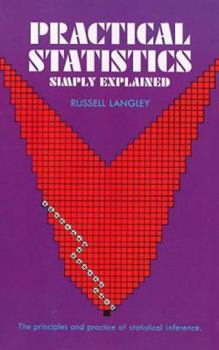Practical Statistics Simply Explained
Select Format
Select Condition 
Book Overview
For those who need to know statistics but shy away from math, this book teaches how to extract truth and draw valid conclusions from numerical data using logic and the philosophy of statistics rather... This description may be from another edition of this product.
Format:Paperback
Language:English
ISBN:0486227294
ISBN13:9780486227290
Release Date:June 1971
Publisher:Dover Publications
Length:399 Pages
Weight:0.15 lbs.
Dimensions:0.9" x 5.4" x 8.5"
Related Subjects
Math Mathematics Science Science & Math Science & Scientists Science & Technology StatisticsCustomer Reviews
5 ratings
Just what the title says
Published by Thriftbooks.com User , 14 years ago
The other reviewers have pretty much said it all. This book is very easy to read, very enjoyable even, but I find it a little verbose (not that this is necessarily a disadvantage). It should be used as an introduction, to give you a strong intuition for the subject. So many books treat the notion of null hypothesis too succinctly. This one does not and gives the subject the attention it deserves. It's accessible to anyone with just high school mathematics. Although the basic notions of probability are explained, this is in an informal manner. As another reviewer said, this book does not deal with the rigorous foundations of Statistics, but should that not be left for a second course?
Finally
Published by Thriftbooks.com User , 15 years ago
The best stats book ever written. I found it in a used book store, and I will use it as the text in my intro stats course.
Lives up to its title
Published by Thriftbooks.com User , 18 years ago
This book is really written to be useful practically, and in that sense it is very successful. It is also written very concisely, so it is likely that it will clear many doubts. However, there are almost no theoretical explanations at all. In this sense, it is not a book that contributes to the theoretical understanding of statistics; so don't expect to know more about theory of statistics using this book; instead get ``Principles of Statistics" by M.G.Bulmer. This is a book to keep on the desk to help do practical statistical calculations and make inferences.
Simple, clear, and hard-working
Published by Thriftbooks.com User , 19 years ago
Maybe you're just getting started as a stats user, maybe you're only an occasional user who doesn't want to relearn the whole field just to get quick answers. In either case, this book might be one of the best around. The first half of the book is background: a little probability, a little bit about sampling and experimental design, a little about the most basic and common statistics (means, quartiles, etc). The second half of the book offers a number of basic parametric and non-parametric significance tests. Langley describes each one, when it is applicable, and how to perform the calculations. He doesn't stray far into the slick computing tricks of the pre-calculator days, so the structure of each calculation stays reasonably clear.The only real weakness in this book is its lack of index. That is especially incovenient because the tables, a staple of most stats books, are interleaved with the text. The table of contents is descriptive, but doesn't replace an index. The other problem, and not really a flaw in the book, is that it's easy to outgrow this text. Even moderately heavy stats users need a bit more theory and background, to allow meaningful adaptation to new conditions. The author has chosen an audience, though, and has addressed that audience and its needs very well. If your skills are beyond those of the intended reader, that's not a fault of the book.Basic, clear, and reasonably broad - it's everything that an ordinary, casual stat user could want.
If you only own one statistics book...
Published by Thriftbooks.com User , 25 years ago
If you only own one statistics book, this should be it! In than 20 years of working with laypeople, engineering and biology undergraduates and grad. students and medical students, this has proven to be the most reliable, intelligible and accessible single volume on how to treat experimental and observational data in a sound, statistically valid, way. Of particular value is a table in the back (Guide to Significance Tests) which takes a "leaf identification" approach to selection of the most appropriate test. Many good examples and problems with solutions makes this an excellent self study text.Jonathan Black, Professor Emeritus, Clemson University.




